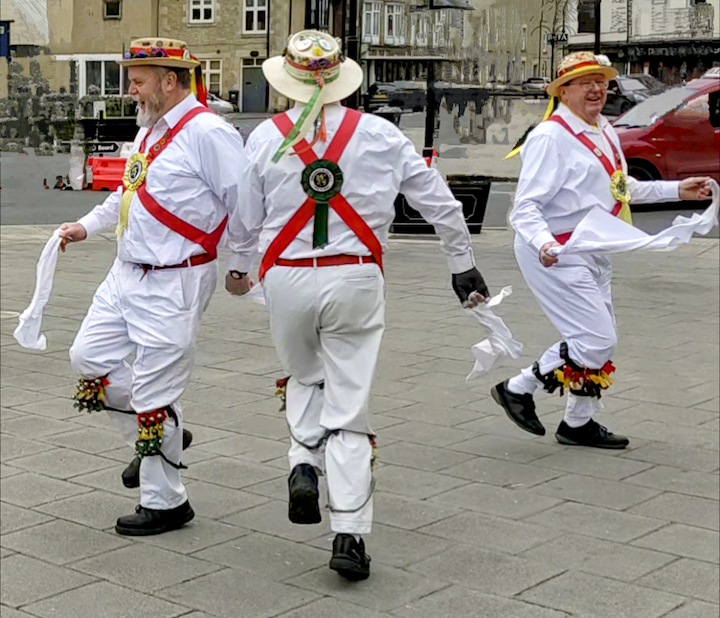Kit to Dance in
Our kit is white, with a red baldric and belt, black shoes and a yellow neckerchief. We wear a straw hat with red, yellow and green ribbons. The bell pads are blue, also with red, yellow and green ribbons, in that order from top to bottom.
Established dancers are provided with rosettes, yellow for the front and green for the back. The colours come originally from the Bathampton School scout group.
We are frequently joined by female dancers, who also wear white with red trim, unless it’s a joint event when they wear the kit of their side.

Some dancers prefer collarless ‘grandad’ shirts, which are available from ‘Workwear Express’ amongst other places. They also sell white trousers (think medical or catering).
You’ll need large (40cm square or larger) white hankies for when dancing in kit. Some swear by silk, but cotton are fine. At rehearsals dancers usually have coloured hankies, which don’t show the dirt as much!
Long and short sticks are provided.
It’s worth asking before you lay out for kit, as the side usually has some spares.

Rehearsals
We rehearse from the beginning of October to the end of April. There’s a short break for Christmas. See the timetable.
We rehearse in the hut behind the Winsley Social Club. Then those who aren’t pressed for time adjourn to the Social Club itself for refreshments.
There’s usually enough parking at the Club, or the D1 bus stops outside. People usually dance in trainers or comfortable shoes. You’ll need a pair of large hankies to practice with (any colour or design), the sort that you can usually buy in an old-fashioned gents’ clothes shop. Sticks are provided.
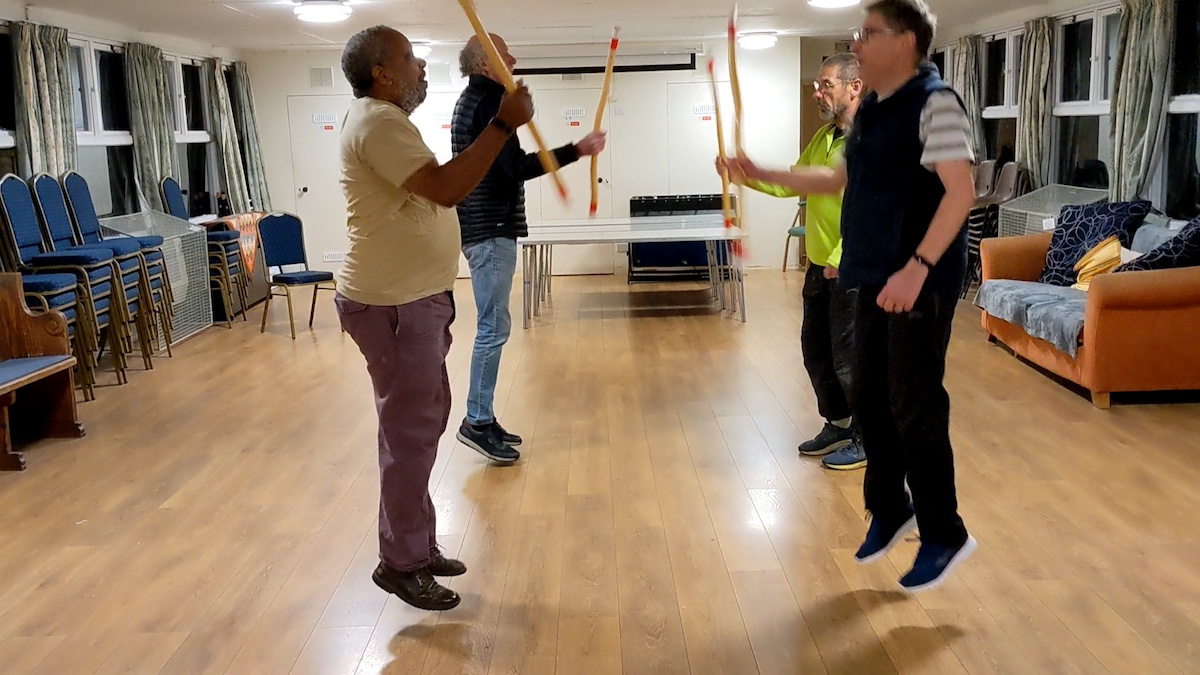
Dancing Out
In the Summer months, rehearsals are swapped for dancing out on Thursday evenings at one or two pubs mostly to the East or South-East of Bath.
There are also traditional dates for dancing:
- Plough Sunday. First or second Sunday of January. Dancing in a church.
- St George’s Day.
- May Day
- First Sunday of August, at the Sidmouth Folk Festival.
- Bathampton Village Fete, in early September.
- Mumming around the year end.
Longer events can include
- Day Tours: A day out dancing in a local town, and trying the local pubs. Often organised by our Fool, Stephen Hausey.
- Weekend tours including our celebrated ‘Welsh Tours’, which go to places like Dorset, or the Cotswolds, or occasionally Wales itself.
And we also get invited to and occasionally host a festival, wassail, village or school event.
The full programme will be provided in March or April. It’s kept up to date on the website. You can also subscribe to this calendar to have it directly in the calendar on your phone or computer. (Details to follow.)
Dances
Bathampton Morris welcome new dancers, whether you’re entirely new to Morris, or have danced with other sides. This section is for those new to Morris. At rehearsals, we’ll help you build up a list of dances you know and enjoy, little by little. Here we introduce some of the jargon.
There are lots of videos of dances on YouTube, but local traditions are strong and Bathampton, like other sides, has its own way of dancing which means you won’t find exactly the same version from other sides. First place to look is the Bathampton Morris YouTube channel.
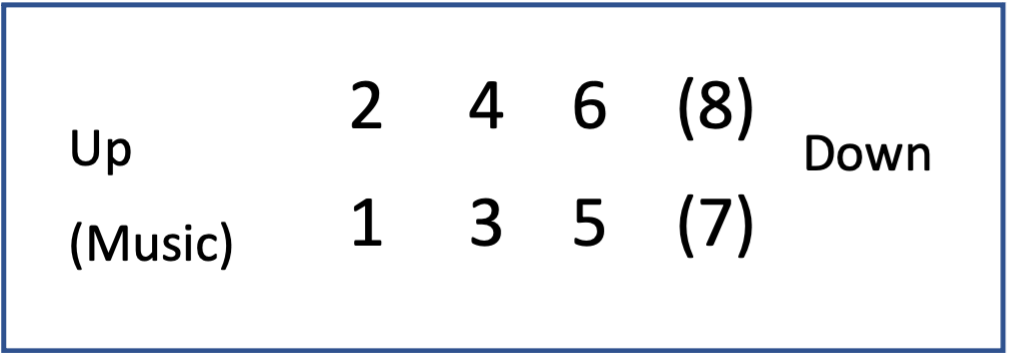
Dances are made up of figures one of which is often repeated as a chorus. (sometimes called the ‘characteristic figure’, because it’s peculiar to that dance). Usually the lead (number 1) will call the next figure as the dance progresses. The most common figures are described here. In brief, we often dance:
- A hey which is a figure-of-eight on the side of the set. Sometimes it’s a half-hey, then a step, then the other half. A few 6-person dances have a hey at the ends of the set.
- In a half-gyp you pass to the opposite side of the dance, then return. First pass right shoulder, then left.
- In a (full) gyp you rotate around the dancer opposite and back to place.
- A back-to-back starts like a half-gyp, but on the far side you step sideways up or down the set to pass back to back, then return.
Within a figure, you move around with steps. The basic steps are single step (step-hop) and double step(step-step-step-hop) and a feet-together jump. What you do with your hands at the same time varies from dance to dance. The English Folk Dance & Song Society have a good set of introductory videos for the steps.
Our first dance is often “Wheatley On” which is a processional dance, with none of the figures listed above, but good for getting to where we need to be!
Music
Endlessly repeated, endlessly enjoyable, bringing bounce and energy, music is an essential part of the dancing.
The main instruments are, from small to large:
- the concertina, compact and often hexagonal, a favourite for its portability,
- the melodeon, larger but similar musically, it’s 8 or more left-hand bass buttons add oomph, and maybe a bit of oompah,
- and the piano accordion, with its piano-like keyboard covering the full chromatic scale (while our concertinas and melodeons are usually in G and D).
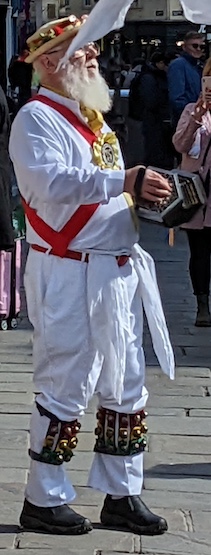

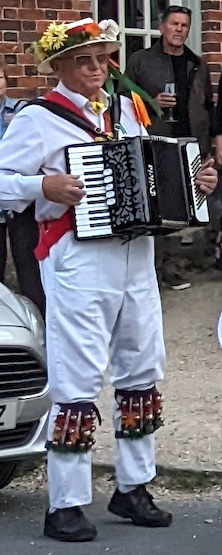
You might well hear the occasional fiddle, guitar, harmonica, whistle and, most important, our tambourine.
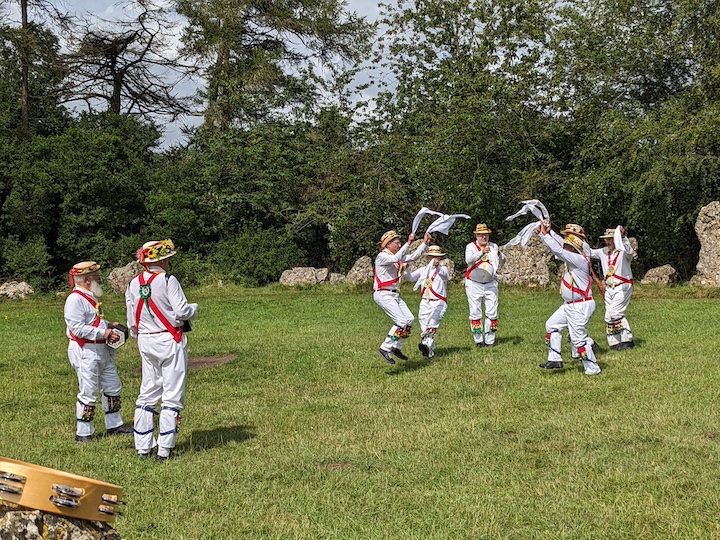
After dancing, we often play and sing for ourselves (and other pub guests!). So even if you’re not ready to play for dancing, bring your instrument along and join in.

Subscriptions
There is no annual subscription to be a member. The club is funded from collections at dances and from the distribution of the programme (and the advertising in it).
Dancers will be asked to chip in for travel, drinks, food. Sometimes these, too, are subsidised by the ‘Bag’.

